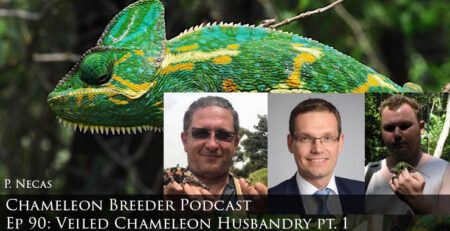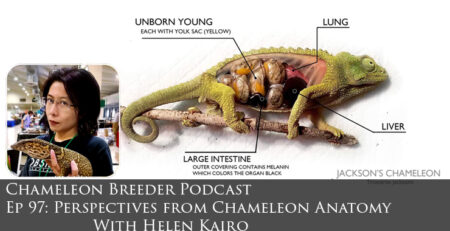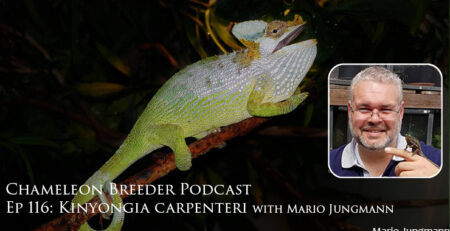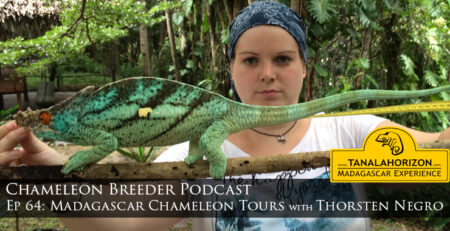Ep 201: The Five Most Asked Chameleon Questions
Listen Here!


Bill Strand
Ep 201: Five most asked Chameleon questions
In this first episode of season six I answer the five questions most often asked by people interested in becoming chameleon keepers. It is important to understand what a chameleon is like before getting one to ensure that you are the right fit for one. If you are excited to allow your chameleon to be what a chameleon is then this can be the start of a long, enriching experience. So, I explain what a chameleon is to allow you to make an informed decision!
Welcome to season six of the Chameleon Academy Podcast!
Transcript (more or less)
Introduction
Welcome to the first episode of season six of the Chameleon Academy Podcast. My name is Bill Strand and it is time to dive in. If you are new to the podcast then you have tapped into the most dynamic and constantly pushing review of chameleon husbandry. We have been doing intense review into a wide range of topics including UVB, supplementation, and the dietary health of veiled chameleons. And in 2021 we will be continuing to expand our understanding. Before we jump into our topic for the day I need to explain how this season is going to work. I’ll make this as short as I can because my new listeners came to hear about chameleons, but this is about the creation of better information resources so it is relevant to the subject.
I have wanted to develop my video outreach for many years. I tried about three years ago and wasn’t able to keep it up because making videos, at least the way I make them, is very difficult to do on a weekly basis if I am doing a podcast and paying a mortgage. So there were some released and then it sputtered. It has come time where that needs to be the top priority. Topics such as UVB and supplementation are great to talk about and have a huge webpage about them, but video will be the most effective medium to communicate those concepts. So I will be wrapping my schedule around the release of the videos. My plan is to do a podcast and video episode release on the schedule that I am able to get them out. I will shoot for every two weeks, but it may become unpredictable until my video production skills hit their stride. But this means each topic will get thorough attention and an effective presentation. The videos will focus on making the topic easy to understand and the podcast will fully flesh out the concepts and the thinking behind them. So the two will be companions. If you are coming to the podcast after watching the YouTube video then you’ll find much more detail and perspective into issues surrounding the points I brought up. In fact there may easily be multiple podcast episodes for each video because I will be talking about the issues surrounding the approach. Nothing is simple and that definitely applies to chameleon husbandry!
The take away from this is that now is a very good time to get the free chameleon academy app on either iTune or Google Play. That way you will be notified when an episode is released. This will be very interesting and kind of cool. There has never been a video/podcast/and website combination before for us Chameleon people and I am exciting to make this happen.
To start this season off I wanted to begin with the first step. What is a chameleon like as a pet and what do we need to consider when making a decision to bring on into our home? The ideal scenario is that you are doing research for a chameleon you are considering buying in the future. Now is the time to make sure you will enjoy what having a chameleon is actually like! If you already have a chameleon then this will help align some of your expectations. If you are wondering why your chameleon doesn’t want to come out and play even though you are his benevolent caretaker then this episode may shed some light on the situation. I am going to start with explaining what chameleon keeping is like at a high level and then answer the five most asked questions from people interested in getting a chameleon. These questions are taken by the highly scientific method of what I answer most often. I could easily make this the 100 best questions to ask before you get a chameleon! But there are many weeks of content creation ahead of us. Let’s start with the five most common actually asked. But first, I’d like to discuss the very open ended question as to what chameleons are like as a pet. The reason why this is not one of the most commonly asked questions is because people often already have a preconceived notion of what it is like. It is what drives their desire for a chameleon in the first place and this forms the basis of desire so it doesn’t always occur to people to question it. So, I want to start off by examining what a chameleon is so we can determine whether our expectations and reality overlap!
What are Chameleons Like?
Chameleons spend their life looking for things to eat and avoid being eaten themselves. When you walk by a chameleon’s cage and you see them swivel around the branch they are hiding. When you see them walking in a jerking manner they are trying to hide their movement by looking like a leaf swaying in the wind. All of this is because their defense against predators is to not be seen. They are not fast animals and they don’t have armor so the best defense is not to be detected. They are so effective with this that field scientists studying them don’t bother searching for them during the day.
This is important because we need to understand that a chameleon reacts to us as something that could eat them. And, that makes sense. For millions of years, assuming that animals bigger than them might eat them has been a very successful method to keep them alive to bug zap another day. This idea of being a pet is completely foreign to them and they have to figure out what this situation means for them. This is why you have such a large range of reactions to captivity from chameleons. The good news is that chameleons are intelligent enough to get used to the idea of you being around. Especially if they are captive hatched and you are the one regularly bringing them food. It is not uncommon for them to be there hanging out at their food dish waiting for you to show up.
So our attitude must be to align our expectations to what they are – NOT to figure out how to bend them to our expectations as to what we want them to be. This is difficult because when we want a chameleon we have a set of expectations. And it is just anti-climatic to re-evaluate our initial desire. What a buzzkill. But there is a living creature involved and that must be respected.
Here is the starting block and if we mess this one up the entire chameleon keeping experience will be off. It will either be disappointing for you or/and an early death for your chameleon. Our mindset must be that we are here to provide for them and we need to accept them as chameleons.
The entire theme of my approach to chameleon husbandry is focused on us providing to them, as much as is possible, what they were developed over the millennium to be nurtured by. And we have to deal with the fact that we look suspiciously similar to what would eat them and they have no parallel in their evolution to being held by something big enough to eat them. And, although they can calm down around us once they get to know us, they physically do not have the part of the brain that is used for what we call love.
So,
What kind of relationship can you have with a chameleon?
Every chameleon will have a different personality so you can’t predict what one will turn out to be. The species, how you care for them, and how young you receive them will all affect how they grow up. Even picking out the calmest baby is not a reliable method because there are many reasons a baby could be calm that will suddenly change once he gets into his own home and then gets his hormones super charged as he grows up. I am not saying he won’t turn into a calm adult. I am just saying the path to adulthood has many variables that cannot be predicted.
The most realistic expectation of keeping a chameleon as a pet is that you are creating a slice of nature in your living room. The enclosure is filled with plant life. And you chameleon weaves in and out of all the plant life to warm itself, hunt for food, and fade back for a good night’s sleep. It becomes more of a visual experience. You are the creator of this world and responsible for maintaining it. In return you are able to observe it and your chameleon growing. And that is the ideal chameleon keeping scenario.
You may have noticed that there is no holding or playing with the chameleon in that scenario. And I know that has disappointed a good number of people wanting a chameleon. We humans have a deep need to touch and hold what we love. And this is how we look at the world. But, chameleons are completely different beings. To be successful with chameleons we need to put our desires aside and open our minds to what they need to be happy.
It usually is not really what we want to hear. Especially after watching Pascal in Disney’s Rapunzel. I know I am going out on a limb challenging the authority of a Disney film. Believe me, I would love to tell you that a chameleon can tame down to be a shoulder pet. But, unfortunately, this is not realistic. If it was, I would be first in line for this species. So the best use I can put my 40 years of studying and keeping chameleons to is to help you see what chameleons truly are. If you come into this with realistic expectations you can be fully prepared and both you and your chameleon will have a much better time of it.
Now, I know this is an immediate turn off for many people. We have the advantage on the podcast that the listening audience here is a little more further along on their herpetoculture path. And this isn’t elitist. You have to be further along to 1) find this podcast in the first place and 2) be excited to listen to chameleon talk for 30 – 45 minutes! And so, I am going to break the fourth wall here and let’s talk about the situation and how we in the community can better deal with newcomers. When people come to chameleon keeping they come from a certain perspective. Some come from the naturalist side where they want to study chameleons and what they are. Obviously, a healthy approach and one that perfectly aligns with what we are doing here. Another approach is seeing a cute chameleon in a pet store, falling in love, and making an emotional choice to buy it. All they have to go off of are the chameleons in the movies and whatever the pet store employee tells them. And pet store employees are not allowed to say “I don’t know”. They are expected to be the experts so they will do their best and share what they have been told – just get this convenient kit and you are good to go. We in the community need to realize that when the mew keepers come to us they have done their research. They asked the pet store guy. And there is no indication that they should doubt his word or do further research because they got a simple, understandable, and case closed care summary. Why should they look further? So we have to realize that it falls to us to help newcomers along through the process. And, if you are this newcomer, I am sorry for how confusing things are. Chameleon keeping is not simple. And the problem with distilling it down to a simple sound bite is you lose a lot of the details that are important. So there are a lot of newcomers that only signed up for something as simple as the pet store said it would be and then find out that there is so much more to it. The fact that you are listening to a chameleon podcast means a lot and you are going to be able to get the information you need. But once you get your feet under you and if you decide to become part of the community your experience with the transition will be a valuable asset to help others.
This all begs the obvious question,
If chameleon keepers do not handle or play with their chameleons, what do they do?
Mostly we watch them. It is deeply satisfying to create their environment and watch both the chameleon and the environment grow. We do develop a relationship with our chameleons. And I don’t mean like we would our dogs. It is a unique chameleon relationship. Chameleons will get to know you because they recognize humans. And they will get to know you and drop their guard around you. Many of them will learn that they can get special treats if they eat from your hand. And once they learn that their cage borders are their territory they will have maintain a sense of security as long as the door is closed. They do have the capacity for trust and trust can be built and it can be broken. Anyone who has had to give a medication routine knows that syringes and forced mouth openings can put back the human/chameleon relationship for a long time. The reason why I focus so much on the least common variable, meaning that chameleons do not want to have anything to do with us, is because most chameleons tend towards the shy range and building expectations that your chameleon can be in the top 5% of friendly is just setting you up for disappointment. If everyone went into to chameleon keeping with the expectation that they would be getting a shy animal that does not want to be held, 95% would get a chameleon as advertised. The other 5% would be posting to social media that I don’t know what I am talking about and that their chameleon loves to come out on their hand and play cards with the family. But none of the chameleons will have keepers disappointed in them because of what they are.
So, with that very important foundation under us, let’s get to those top five questions are that I am asked by people thinking about getting chameleon.
The #1 question is Can I hold my chameleon?
Boy, this one just keeps coming up in various forms!
And this presents an immediate challenge for the experienced chameleon keeper to answer. Our answer would be no, chameleons are not a pet for holding. And that would be the right answer. But we need to go beyond that and address what the beginner will see all over social media. People are holding their chameleons all over the place! And the most experienced keepers and breeders are holding their chameleons. You go on my social media feeds and event he video where I say don’t handle your chameleons and I have them on my hand! So we are obligated to explain the situation. And here is where it gets murky. How to make a complicated subject simple. Good luck. I did an entire extra long podcast episode on stress and now I have to distill it down to a couple of sound bites before the newcomer’s eyes glaze over? Yikes…
But, here is the real answer.
Proposition: Handling a chameleon causes stress with that chameleon. True. How much stress depends on the personality of the chameleon and the nature of the handling session.
Proposition: Stress kills chameleons. True.
Just like in human beings, stress taxes the immune system and weakens it until a sickness can take hold. Then we, and chameleons, get sick. Sickness in chameleons leads to death more often than in humans because it is difficult to know when a chameleon is sick until it is so far along that the chameleon can’t function.
Proposition: If handling causes stress, and stress causes death, then by the transitive property of equality (for all you math nerds out there)- Handling causes death. Only partially true.
The reason is that there are two types of stress. There are stress spikes and chronic stress. A stress spike is like when we get cut off in traffic. Adrenaline goes through our body, we say things that we hope our kids don’t repeat, and then we go back to normal. Your immune system does not become depressed from a stress spike. You aren’t going to catch a cold from being cut off in traffic one day.
Chronic stress is something different. This is where your body is stressed so does not get a chance to recover. This is having the air conditioning vent blowing directly on you all day at work. This is knowing that there will be lay-offs at the end of the month and everyone at the office is trying to make everyone else look bad to decrease their chances of being cut. This is being forced to live in and work in a house with a Bengal tiger loose. Eventually the stress will cause you to get sick. Was the tiger example ridiculous? Well, maybe we can imagine what a chameleon feels when, everyday, they get blown on by the air conditioning vent, then the sun comes through the window and bakes them which brings the house cat to come and lounge by the cage. You can see how things we would never think of could cause chronic stress to a chameleon that has had its options reduced by being in a cage. This is why we have such a high responsibility in this.
So, where does handling fit into all this. Just taking your chameleon out and letting him perch on your hand for a visual examination is a simple stress spike that goes as high as the chameleon is nervous. I have some chameleons that send their time on my hand worried I will eat them and some that see my hand as something that will take them to a good thing to eat. These two chameleons are having completely different stress responses. A trip to a vet is a much longer stress spike, but it too, will be over and not be repeated every day. A photoshoot is a stress spike that is not a health issue. Handling becomes an issue when the stress starts going through the roof. Such as when we play with a chameleon. The hand over hand as the chameleon keeps walking is great fun, except that the chameleon is trying to get away. So to your chameleon it is an exercise in futility that they will do until they give up and decide they can’t do anything to avoid being eaten. They close their eyes and the well meaning human assumes they are tuckered out and trust them enough to sleep on their hand. A chameleon sleeping on your hand is a huge red flag. This is exhaustion, not trust. And this is the problem. If we say you cant handle your chameleon, the beginner who is excited for their Pascal will just go to some YouTube personality that says all those supposed experts are just fuddy duddies and of course you can hold your chameleon You just have to tame him down by handling him every day. It is hard to compete with someone telling someone exactly what they want to hear. All I can do is share what a chameleon is and hopefully it resonates.
So, yes, limited, calm handling is okay. But if handling is an important part of your pet relationship then it is best to look for another type of reptile or pet. That is just not what a chameleon is.
Question 2: Will a chameleon bite?
The second most asked question is whether a chameleon will bite. The answer is only if they have to! Chameleons don’t like to bite. They bite to get you to go away. And it is never a secret that they are about to bite. They give unmistakable warning signs. They puff up, they gape, they show their teeth, they make fake lunges to let you know they are serious. And if you ignore all that, yes, a bite is coming your way. And larger chameleons can break the skin. But, no, chameleons will not come after you. The people who get bit most often are those who ignore all the warnings and insist on picking up a chameleon that is not interested in being picked up.
The third question is What equipment do I need for a chameleon?
And this is a big question with a very long answer that can easily spread across an entire year of podcasts. And this is why it is so important to have the chameleonacademy.com website to back up both the video and podcast series. In it I can put together build guides that lead the person step-by-step and have purchase links.
If you are a beginner listening to this then the build guides are your best approach. In them you will see how the main components all fit together. Basically, you have a cage, a lighting system, and watering system. The cage needs to be at least 2’x2’x4’ for most of the available chameleon species. Lighting consists of three parts – Daylight for sight, a basking bulb for warming up, and a UVB bulb for Ultraviolet wavelengths that allow the chameleon to create vitamin D3. A full watering system consists of a mister, a fogger, and a dripper. And then there are the plants for the inside. You don’t have to memorize this all right now. You have the links for the build guides on the podcast show notes that lead you step by step.
I have been spending literally years putting together these build guides. And I have to update them every year because products are no longer available or I find better products. And that is why it is a huge advantage to have a website to refer to.
The most controversial part about this build guide will be the hydration system. I do my build guides using a mister, fogger, and dripper. Every influencer or group will have their own approach. This is one of the areas where you want to pick your source and follow one source. If you ask around you will get many opinions. The reason why there can be so many opinions is that the benefits of different watering approaches are subtle and difficult to quantify. We don’t have renal failure on all chameleons using one approach or the other. I am certain that there is a long term effect on longevity, but there is no hard data to prove either way. This question touches on the bulk of chameleon husbandry so any short answer is incomplete. But the important thing for a beginner to take into account, at a high level, is that getting a chameleon means you will have a 2’x2x’x4’ or larger cage in your room with a watering system and a light system. Each of these three will be $100-$200 USD each with the cage going up in price depending on the quality you are wanting.
Question #4 is What do they eat?
-They eat bugs. Live Insects. Not only that, you need to feed and take care of the bugs so they are nutritious to the chameleon. Just make sure you are good with bugs before starting in this direction. Many chameleon keepers become bug breeders as well to give you an idea of where this often ends up. Chameleons need live insects so any thought of using the freeze-dried bugs can be let loose now. Would it help for me to say that many chameleon keepers take pride in their roach colonies? Did I just complicate your campaign to get your spouse to agree to a chameleon? Well, to try and save the day I will say you don’t have to keep roaches. But it is worth looking at the resources I have in the show notes to get familiar with the eating habits of chameleons and make sure you are totally comfortable with keeping live insects around the house. Once again that is just what chameleons are.
And, finally,
Question 5: Will a chameleon just die on me?
We have a long history of chameleons being thought of as fragile. This was fuelled by chameleons being treated roughly during the exportation process and then being kept inappropriately when they get here. Things are much better now over what they were decades ago. The importation process has improved and our husbandry knowledge is world’s better.
Chameleons are hardy animals. When set-up correctly they can live 7 to 10 to 15 or more years depending on the species. But we do have to keep them correctly.
If you set any animal up incorrectly they will die. If we were pets for polar bears and they kept us in ice caves we wouldn’t do so well. Chameleons are designed to survive in nature that tries to kill or eat them at every turn. Nature is not nice! I can guarantee you, they are tough creatures! All you have to do is set the chameleon up correctly and he will thrive! And that, of course, is what this podcast is all about.
As far as we have gotten there is so much more work to be done. We are lucky to be in a stage of herpetoculture where our focus for the most commonly kept species is no longer just keeping them alive or even breeding them, but longevity. Yes, what we don’t know dwarfs what we do know and we will not establish successful reproductive protocols for each and every species in my lifetime. But for the most common species such as Veiled, Panther, and Jackson’s Chameleons, we are working on refining our husbandry to push their longevity to the ten year mark. And that goal is completely arbitrary. There will be an internal limit to how old they can get. Our goal is to get our husbandry to the point where we find it. So this is actually an exciting time. We are entering into a stage in our discipline where we have the tools to explore longevity as a goal. And I am not talking about isolated incidences. Yes, hearing about some veiled chameleon somewhere that reached a ripe old age is great news, but it really isn’t an accomplishment until we can establish husbandry practices that allow the general community to reach those ages. And this will take time. The general community is still producing veiled chameleons that are overweight and producing unhealthy egg clutch sizes. So there is a lot of work we have to do and with longevity, proving anything can only be done over long periods of time.
Closing
Those are our five questions. Though half the podcast was taken up by the initial question about chameleon nature that I threw in there! The companion video to this episode then went on to discuss a number of dos and donts that I selected as the ones I would pick if I were trying to find the most important points. Once again, I could easily make them 100 dos and 100 donts! But we will take those apart in the next podcast episode.
2021 will be a year where we solidify the basics. The Chameleon Academy only has one term, Basic Husbandry, released. There are actually four terms planned! But there is much more that needs to be done to distill the basics. Video is very important so it is the priority. You’ll see each section in the term being fleshed out and made more robust.
I am very aware of the fact that I produce complicated content. I have struggled with reducing the presentation because I have a hard time leaving out important aspects. Chameleon husbandry is not an infographic! So this is my approach to each topic: I am going to create a solid base of information and work my way up. Once I have a detailed website page and podcast episodes that discuss the topic, explain it , and show the research behind it I will create a video that summarizes it visually. And then I will have an infographic that simplifies it even further to sit on top of that mountain. That way, there is depth for the person who wants to dig.
And then, there is the simple task of updating that mountain of content every time we discover something new! Considering how fast we are moving forward, I don’t think I’ll be bored anytime soon!
Thank you for joining me here. Chameleon keeping has meant more to me than just keeping a lizard pet. Dedicating myself to the discipline of herpetoculture with an emphasis on chameleonology has become a lifelong pursuit and has exposed me to parts of nature I never knew existed. It has been a wonderful experience and I look forward to many more years of personal growth. And, I look forward to sharing the journey with you.













